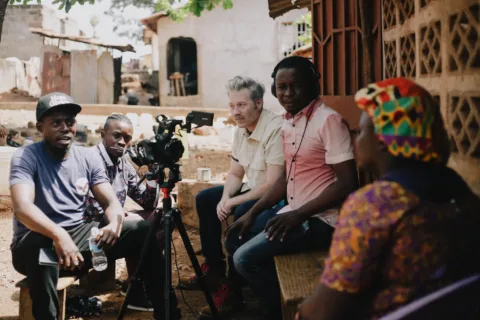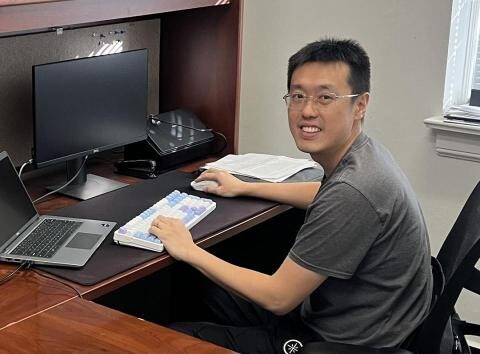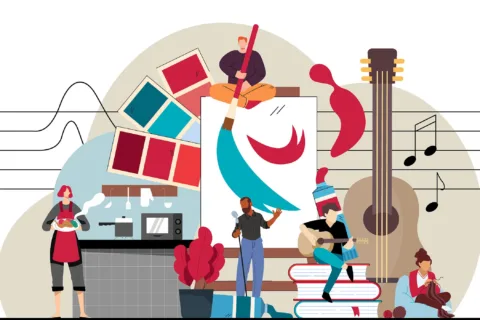News Articles
News Articles
Tamlin Hall named director of MFA Film, Television and Digital Media program
December 18, 2025Tamlin Hall, an Emmy Award-winning filmmaker, director, producer, educator and non-profit founder, has been named the new director of the University of Georgia Master of Fine Arts in Film, Television and Digital Media.
A Virus Takes Flight
December 17, 2025Avian influenza isn’t new. But the most recent outbreak’s rapid and prolific spread is setting off alarm bells. Issabella Asamoah, graduate research assistant, S. Mark Tompkins, professor and director for the Center for Vaccines and Immunology, and Justin Shepard, PhD student, work in the Tompkins laboratory in the College of Veterinary Medicine. “Arguably, we are in the age of pandemics.” It’s a bold statement. And perhaps hyperbolic. But when someone like Justin Bahl says it, you should probably listen.
The Ed.D. in Learning Design & Technology to host Information Session on January 5, 2026.
December 15, 2025The Learning, Design, and Technology program is excited to announce that we will be hosting two upcoming information sessions on Monday, January 5, 2026, for prospective students interested in the Ed.D. in Learning, Design, and Technology. https://calendar.uga.edu/search/events?search=LDT 1pm-2pm EST 6pm-7pm EST These sessions are designed to help you learn…
Tom Sapp: The Man Behind the Mascot
December 3, 2025Hairy Dawg was born in a basement, and he was delivered in a hurry. Three weeks before Georgia’s showdown against Notre Dame in the 1981 Sugar Bowl, Tom Sapp BFA ’69 showed coach Vince Dooley some sketches for an idea he had. They depicted a broad-shouldered, tough-looking figure with a bulldog’s head, oversized paws, and a football player’s body. Dooley liked the idea and said Sapp could build the costume—but only if he could have it ready in time for the bowl game.
With an Online Community Nutrition Degree, FACS Student Helps Strengthen Rural Georgia Communities
December 3, 2025Ashleigh Guerin’s path to Extension work started in rural South Georgia, where her interest in outreach and community education first took shape. When she transferred to UGA, she found an immediate sense of direction. Walking into Dawson Hall, she said it felt like home, and the coursework she dove into soon became the backbone of the work she does today. Classes in food principles, food safety, chronic disease prevention, and financial planning weren’t just academic exercises for her, they were skills she now teaches every day.
Online MS in Applied Data Science Approaches the End of a Successful First Semester
November 29, 2025UGA’s online MS in Applied Data Science marks a successful first semester, with its inaugural cohort diving into programming, analytics, machine learning, and real-world data applications. Learn how this flexible graduate program supports working professionals and prepares students for data-driven careers.
Free News Subscriptions for UGA Students and Faculty: NYT, WSJ, AJC, and More
November 25, 2025UGA students, faculty, and staff can get free digital access to major publications including The New York Times, The Wall Street Journal, the AJC, and The Chronicle of Higher Education through UGA Libraries. Learn how to activate your subscriptions.
UGA Fall 2025 Commencement: What Online Graduates Need to Know
November 18, 2025Get ready for UGA’s Fall 2025 Graduate Commencement on December 12 at Stegeman Coliseum. Find details on parking, accessibility, regalia, viewing options, speakers, and diploma timelines for online graduate students.
Dr. Yuan Ke & team receive new research award from U.S. National Science Foundation and the Swiss National Science Foundation
November 17, 2025Dr. Yuan Ke, together with Prof. Runze Li (Pennsylvania State University) and Prof. Stéphane Guerrier (University of Geneva), received a new research award from the joint program of the U.S. National Science Foundation (NSF) and the Swiss National Science Foundation (SNSF).
New Study from Sakhavat Mammadov Connects Daily Emotions and Creative Engagement
November 12, 2025Your happiness and self-fulfillment might have a direct impact on how creative you are, according to new research from the University of Georgia. Researchers from the UGA Mary Frances Early College of Education found that positive emotions can translate to increased engagement in creative activities like drawing, writing and playing music. This study suggests that day-to-day emotions are more influential than personality when it comes to engaging with creative actions. And that creativity may also improve well-being.










